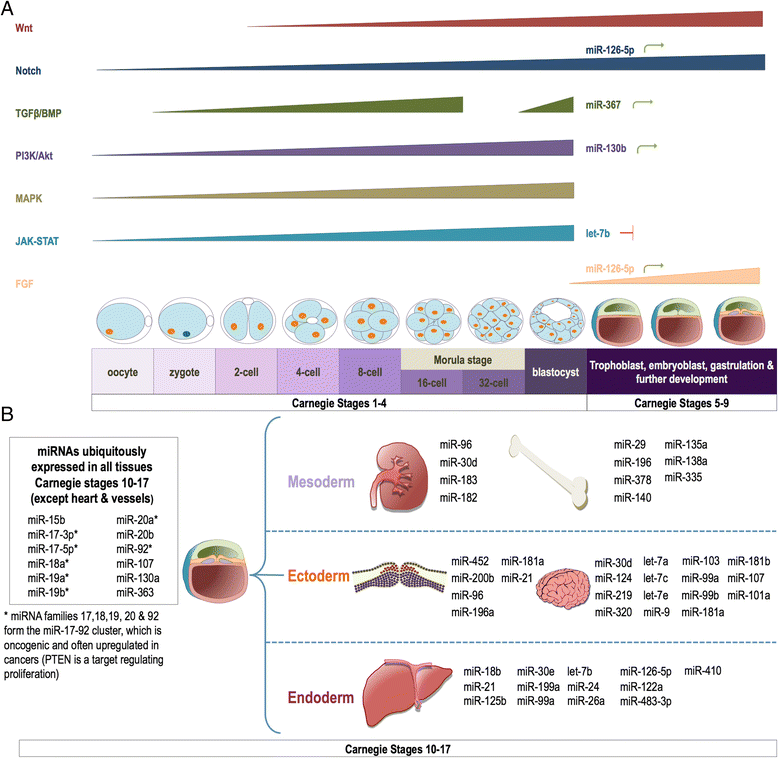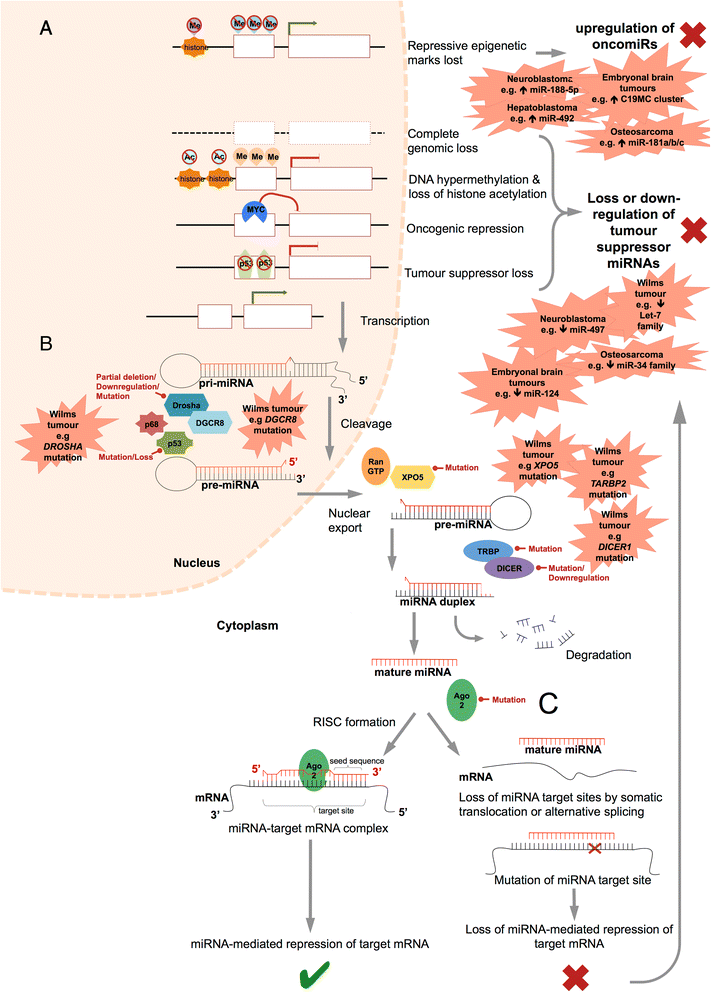MicroRNA expression patterns and signalling pathways in the development and progression of childhood solid tumours
- PMID: 28103887
- PMCID: PMC5248531
- DOI: 10.1186/s12943-017-0584-0
MicroRNA expression patterns and signalling pathways in the development and progression of childhood solid tumours
Abstract
The development of childhood solid tumours is tied to early developmental processes. These tumours may be complex and heterogeneous, and elucidating the aberrant mechanisms that alter the early embryonic environment and lead to disease is essential to our understanding of how these tumours function. MicroRNAs (miRNAs) are vital regulators of gene expression at all stages of development, and their crosstalk via developmental signalling pathways is essential for orchestrating regulatory control in processes such as proliferation, differentiation and apoptosis of cells. Oncogenesis, from aberrant miRNA expression, can occur through amplification and overexpression of oncogenic miRNAs (oncomiRs), genetic loss of tumour suppressor miRNAs, and global miRNA reduction from genetic and epigenetic alterations in the components regulating miRNA biogenesis. While few driver mutations have been identified in many of these types of tumours, abnormal miRNA expression has been found in a number of childhood solid tumours compared to normal tissue. An exploration of the network of key developmental pathways and interacting miRNAs may provide insight into the development of childhood solid malignancies and how key regulators are affected. Here we present a comprehensive introduction to the roles and implications of miRNAs in normal early development and childhood solid tumours, highlighting several tumours in depth, including embryonal brain tumours, neuroblastoma, osteosarcoma, Wilms tumour, and hepatoblastoma. In light of recent literature describing newer classifications and subtyping of tumours based on miRNA profiling, we discuss commonly identified miRNAs, clusters or families associated with several solid tumours and future directions for improving therapeutic approaches.
Keywords: Childhood solid tumours; Early development; Hepatoblastoma; Medulloblastoma; MicroRNAs; Neuroblastoma; Osteosarcoma; Wilms Tumour.
Figures


Similar articles
-
A sketch of known and novel MYCN-associated miRNA networks in neuroblastoma.Oncol Rep. 2017 Jul;38(1):3-20. doi: 10.3892/or.2017.5701. Epub 2017 Jun 6. Oncol Rep. 2017. PMID: 28586032 Free PMC article.
-
MicroRNA expression and gene regulation drive breast cancer progression and metastasis in PyMT mice.Breast Cancer Res. 2016 Jul 22;18(1):75. doi: 10.1186/s13058-016-0735-z. Breast Cancer Res. 2016. PMID: 27449149 Free PMC article.
-
MicroRNA biogenesis pathways in cancer.Nat Rev Cancer. 2015 Jun;15(6):321-33. doi: 10.1038/nrc3932. Nat Rev Cancer. 2015. PMID: 25998712 Free PMC article. Review.
-
Recurrent DICER1 hotspot mutations in endometrial tumours and their impact on microRNA biogenesis.J Pathol. 2015 Oct;237(2):215-25. doi: 10.1002/path.4569. Epub 2015 Jul 6. J Pathol. 2015. PMID: 26033159
-
MicroRNA in pancreatic cancer.J Hum Genet. 2017 Jan;62(1):33-40. doi: 10.1038/jhg.2016.59. Epub 2016 Jun 2. J Hum Genet. 2017. PMID: 27251005 Review.
Cited by
-
Long noncoding RNA LeXis promotes osteosarcoma growth through upregulation of CTNNB1 expression.Am J Cancer Res. 2017 Jul 1;7(7):1577-1587. eCollection 2017. Am J Cancer Res. 2017. PMID: 28744406 Free PMC article.
-
KLF9 regulates miR-338-3p/NRCAM axis to block the progression of osteosarcoma cells.J Cancer. 2022 Mar 28;13(6):2029-2039. doi: 10.7150/jca.63533. eCollection 2022. J Cancer. 2022. PMID: 35399713 Free PMC article.
-
Dysregulated circular RNAs in medulloblastoma regulate proliferation and growth of tumor cells via host genes.Cancer Med. 2018 Dec;7(12):6147-6157. doi: 10.1002/cam4.1613. Epub 2018 Nov 6. Cancer Med. 2018. PMID: 30402980 Free PMC article.
-
Tumor-Derived Extracellular Vesicles: Their Role in Immune Cells and Immunotherapy.Int J Nanomedicine. 2021 Aug 10;16:5395-5409. doi: 10.2147/IJN.S313912. eCollection 2021. Int J Nanomedicine. 2021. PMID: 34408415 Free PMC article. Review.
-
The new horizon of liquid biopsy in sarcoma: the potential utility of circulating tumor nucleic acids.J Cancer. 2020 Jul 9;11(18):5293-5308. doi: 10.7150/jca.42816. eCollection 2020. J Cancer. 2020. PMID: 32742476 Free PMC article. Review.
References
-
- Ohno S: So much “junk” DNA in our genome. In: Brookhaven Symp Biol. New York: Gordon & Breach; 1972. p. 366–70. - PubMed
Publication types
MeSH terms
Substances
LinkOut - more resources
Full Text Sources
Other Literature Sources

